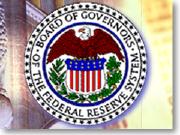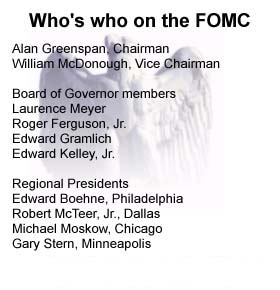|
Who's who on the FOMC
|
 |
August 23, 1999: 6:05 p.m. ET
Greenspan's supporting cast helps make interest rate decisions
|
NEW YORK (CNNfn) - While Alan Greenspan is a well-recognized name, the Federal Reserve chairman has an impressive, if relatively unsung supporting cast when the time comes to set U.S. interest rate policy.
It is the Federal Open Market Committee, which sets short-term monetary policy for the country's central bank based on a variety of domestic and international economic factors.
The committee is allowed 12 members - including seven members of the Fed's Board of Governors, the president of the Federal Reserve Bank of New York and four rotating seats consisting of the presidents of the eleven other Reserve Banks.
On June 3, Fed Vice Chairman Alice Rivlin resigned, leaving the committee with 10 members for the time being. There are currently five board governors and five regional bank presidents on the committee.

Following are highlights of the current board members' careers.

Greenspan
Alan Greenspan, the FOMC chairman, is serving his third four-year term as chairman of the board of governors of the Federal Reserve System. He has been appointed by Presidents Reagan, Bush and Clinton.
Before joining the Fed in 1987, Greenspan was chairman and president of the New York-based economic consulting firm Townsend-Greenspan & Co. Inc. for 30 years from 1954 to 1987. In the middle of that stretch, from 1974 to 1977, Greenspan served as chairman of the Council of Economic Advisers under President Ford, and from 1981 to 1983 as chairman of the National Commission on Social Security Reform.
Greenspan is famous for his cautious -- if opaque -- public statements about monetary policy. Among his most recognized statements was his 1996 remark that U.S. stock markets were experiencing "irrational exuberance."

McDonough
William J. McDonough, vice chairman of the FOMC, has been president of the Federal Reserve Bank of New York since 1993, a year after first joining the bank and serving as its executive vice president, as well as manager of open market operations at the FOMC.
Prior to his work at the Fed, McDonough served as vice chairman of the board of First Chicago Corp., where he worked for 22 years in various executive positions, including chief financial officer and as a director of its bank holding company from 1986 until 1989.

Boehne
Edward G. Boehne, president of the Philadelphia Fed since 1981, has spent his entire career with that body. Joining the Fed in 1968 as an economist, Boehne served in a variety of positions, including vice president, director of research and senior vice president.

Ferguson
Roger W. Ferguson Jr., a Federal Reserve governor since 1997 and now Vice Chairman of the Fed, was a partner at the international management consulting firm McKinsey & Co. Inc. There he managed studies for financial institutions for 13 years and served as director of the firm's research and information systems, managing its investments in knowledge management technologies. Prior to that, Ferguson was a lawyer at the firm Davis Polk & Wardwell, where his casework included syndicated loans, public offerings and mergers and acquisitions.

Gramlich
Before joining the Federal Reserve Board of Governors in 1997, Edward M. Gramlich served for three years as the dean of the School of Public Policy at the University of Michigan, where he had been a professor of economics and public policy since 1976. During his academic tenure, Gramlich acquired extensive governmental experience through a variety of appointments, including chairman of the Quadrennial Advisory Council on Social Security, acting director of the Congressional Budget Office and director of policy research at the Office of Economic Opportunity.

Kelley
Edward W. Kelley Jr., has served as a Federal Reserve governor since 1987. From 1959 to 1981, he served as president and CEO of Kelley Industries Inc., a Houston-based holding company with subsidiaries in manufacturing, distribution and business services. A founding director of three banks in the Houston area, Kelley also became board chairman of Investment Advisors Inc. in the 1980s.

McTeer
Dallas Federal Reserve Bank President Robert D. McTeer took office in 1991. He began his career at the Federal Reserve Bank of Richmond in 1968 as an economist in the research department. In 1980, McTeer became senior vice president in charge of the Baltimore branch of the Richmond Reserve Bank, where he served until joining the Dallas Fed.

Meyer
Widely recognized as one of the nation's leading economic forecasters, Laurence H. Meyer joined the Federal Reserve board in 1996, having once served as an economist at the Federal Reserve Bank of New York. In 1982, he co-founded Laurence H. Meyer and Associates, a St. Louis-based economic consulting firm, where he served as president until being named to the Fed. He also taught economics for 27 years at Washington University, where for a time he chaired the economics department.

Moskow
Chicago Federal Reserve President Michael H. Moskow took office in 1994, a veteran of the educational, governmental and corporate worlds. Moskow began his career as a professor of economics, labor relations and management at three colleges in Pennsylvania. For eight years after that, he served in several high positions in the federal government, such as the Council of Economic Advisers, the Department of Housing and Urban Development and the Labor Department.
In 1977, he took to business, working for a variety of firms in the Chicago area. President Bush in 1991 named Moskow as deputy U.S. trade representative. Two years later, Moskow returned to the teaching world, at the J. L. Kellogg School of Management at Northwestern University.

Stern
Minneapolis Federal Reserve Bank President Gary H. Stern took office in 1985, taking the helm of that regional Fed just three years after joining its staff. In 1982, Stern joined the Minneapolis Fed as senior vice president and director of research. Prior to that, he was a partner in a New York-based economic consulting firm. He also served on faculties of Columbia University, Washington University and New York University.
There are also four alternate members, made up of the remaining Federal Reserve Bank presidents, but those seats hold no voting powers on official board matters unless one of the voting presidents cannot attend.
Currently, the four alternate board members are J. Alfred Broaddus, president of the Fed bank in Richmond, Jack Guynn, president of the Atlanta bank, Jerry L. Jordon, president of the Cleveland bank, and Robert T. Perry, president of the San Francisco bank. 
|
|
|
|
|
 |

|

